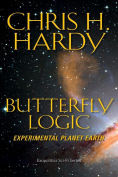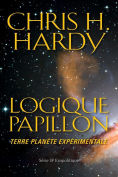CHRIS H.
HARDY – 3 NEW BOOKS PUBLISHED JUNE-JULY 2016
* 25 July, 2016: Wars of the Anunnaki:
Nuclear Self-Destruction in Ancient Sumer.
"Ancient Astronauts Foreword" by Jim Marrs. Rochester, Vt.: Inner Traditions, 2016.
Nuclear Self-Destruction in Ancient Sumer.
"Ancient Astronauts Foreword" by Jim Marrs. Rochester, Vt.: Inner Traditions, 2016.
Find/buy it on Amazon
Examines the
Anunnaki gods’ evolving relationships with humanity, their power struggles, and
the details of their nuclear war on Earth
• Analyzes the crisis and rationale behind the Anunnaki decision to nuke 5 cities in the Jordan plain (including Sodom and Gomorrah), resulting in the obliteration of Sumerian civilization
• Draws upon the work of Zecharia Sitchin, the Book of Genesis, Sumerian clay tablets, and archaeological evidence such as ancient radioactive skeletons
• Examines the Anunnakis’ lack of higher consciousness, their reliance on technology, their sacred power objects and sacred geometry, and the possibility of Anunnaki bases on Mars in the distant past
The detonation of nuclear weapons in the 20th century was not the first time humanity has seen such terrible destruction. Drawing upon Sumerian clay tablets, the Book of Genesis, and archaeological evidence such as ancient radioactive skeletons, Chris Hardy reveals the ancient nuclear event that destroyed the Sumerian civilization and the power struggles of the “gods” that led up to it.
The author explains how the Anunnaki came to Earth from the planet Nibiru seeking gold to repair their ozone layer. Using genetic engineering, they created modern humanity to do their mining work and installed themselves as our kings and our gods. Anunnaki god Enki had a fatherly relationship with the first two humans. Then Enlil, Enki’s brother, took over as Commander of Earth, instating a sole-god theocracy and a war against the clan of Enki and humanity for spoiling the Anunnaki bloodlines through interbreeding. This shift imposed a blackout not only of the very human nature of the Anunnaki “gods” but also of humanity’s own ancient past on Earth.
Two of Enlil’s attacks against the Enki clan and humanity are described in the stories of the Deluge and the Tower of Babel. His final attempt, after coercing the Assembly of the Gods into voting yes, was the nuclear bombing of 5 cities of the Jordan plain, including Sodom and Gomorrah, which resulted in the destruction of the Sumerian civilization and the Anunnakis’ own civilization on Earth, including their space port in the Sinai. The author reveals how, after each attempt, humanity was saved by Enki, chief scientist Ninmah, and Enki’s son Hermes.
The author explores how the Anunnakis’ reliance on technology and their recurrent wars caused them to lose touch with cosmic consciousness. And she reveals how we will be doomed to repeat this dynamic until humanity awakens to our true origins.
• Analyzes the crisis and rationale behind the Anunnaki decision to nuke 5 cities in the Jordan plain (including Sodom and Gomorrah), resulting in the obliteration of Sumerian civilization
• Draws upon the work of Zecharia Sitchin, the Book of Genesis, Sumerian clay tablets, and archaeological evidence such as ancient radioactive skeletons
• Examines the Anunnakis’ lack of higher consciousness, their reliance on technology, their sacred power objects and sacred geometry, and the possibility of Anunnaki bases on Mars in the distant past
The detonation of nuclear weapons in the 20th century was not the first time humanity has seen such terrible destruction. Drawing upon Sumerian clay tablets, the Book of Genesis, and archaeological evidence such as ancient radioactive skeletons, Chris Hardy reveals the ancient nuclear event that destroyed the Sumerian civilization and the power struggles of the “gods” that led up to it.
The author explains how the Anunnaki came to Earth from the planet Nibiru seeking gold to repair their ozone layer. Using genetic engineering, they created modern humanity to do their mining work and installed themselves as our kings and our gods. Anunnaki god Enki had a fatherly relationship with the first two humans. Then Enlil, Enki’s brother, took over as Commander of Earth, instating a sole-god theocracy and a war against the clan of Enki and humanity for spoiling the Anunnaki bloodlines through interbreeding. This shift imposed a blackout not only of the very human nature of the Anunnaki “gods” but also of humanity’s own ancient past on Earth.
Two of Enlil’s attacks against the Enki clan and humanity are described in the stories of the Deluge and the Tower of Babel. His final attempt, after coercing the Assembly of the Gods into voting yes, was the nuclear bombing of 5 cities of the Jordan plain, including Sodom and Gomorrah, which resulted in the destruction of the Sumerian civilization and the Anunnakis’ own civilization on Earth, including their space port in the Sinai. The author reveals how, after each attempt, humanity was saved by Enki, chief scientist Ninmah, and Enki’s son Hermes.
The author explores how the Anunnakis’ reliance on technology and their recurrent wars caused them to lose touch with cosmic consciousness. And she reveals how we will be doomed to repeat this dynamic until humanity awakens to our true origins.
Short bio
Chris H. Hardy, Ph.D. in psychological anthropology, a
scientist and a seer, cognitive and systems theorist, is a long-time researcher
on consciousness and psi, both in terms of theory and as a continuous inner
path of exploration of novel mental capacities. She made a breakthrough in the
comparison of Sumerian tablets accounts with that of the Book of Genesis, using
Semantic Fields Theory to sort out 3 distinct narrators in their different
cultural and time frames; as well as in the careful gathering of evidence of
the use of nuclear WMD by the Ancient Aliens, or Anunnaki, on earth in her
books: DNA of the Gods (on Inner Traditions’
bestsellers list) and Wars of theAnunnaki, Self-Destruction in Ancient Sumer.
* 23 June, 2016: Butterfly Logic: Experimental Planet Earth. CreateSpace IPP, USA.
French version (by the author):
* 2016 (June 23). Logique Papillon: Terre
Planète Expérimentale. (Série SF exopolitique) CreateSpace IPP, USA..
Trouver/Acheter sur Amazon.fr
----------------------------------------------------------------------------------------
----------------------------------------------------------------------------------------
Butterfly Logic
Find it on Amazon.com :
The Unikarg empire, controlled by officials on Exora—a whole
management planet run by computers (exors)—has become an inert superstructure which,
despite its high technology, is incapable of producing any new discoveries,
ideas, art, even humor; the stimulants of change and difference, the challenges
of the unexpected, all the vehicles of vitality and growth have been running
down.
The only glimmer of hope is a long-forgotten massive experiment
launched eons ago by the genius Zeera who, having anticipated this decline, had
set up the Plan for Experimental Planets (PEP). It involved seeding genetic
diversity and disorder on planexes under the hypothesis that this would yield a
new breed of sapiens, minds and civilizations whose dynamism would rekindle the
creative spirit on Unikarg.
Erdoes starts a new phase of the PEP and investigates his hunch of a
major trafficking in humans, technology and resources on Trisorbe/Earth. He
sets up a collective learning network involving pairs of sapiens-exors, whose
leading one, Shari-Sphinx, starts developing a Meta-spatial Logic of
transformation and synergy that triggers qualitative leaps in sapiens and exors
alike, and tools that will be used to fight against the alien Mafioso ring on
Earth. The fight is raging – will Shari and Sphinx be able to defeat them?
Butterfly Logic offers
a fresh look on diversity, creativity, chaos, artificial intelligence, and the
human mind. Quick paced, provocative and humorous, this sci-fi deals primarily
with the dangers of uniformization and a too tight control on people and
society, as well as with a logic enabling computers to learn exponentially,
while remaining the sure allies of sapiens and humans.
(See a longer presentation on my
academia.edu page:
xxxxxxxxxxxxxxxxxxxxxxxxxxxxxxxxxxxxxxxxxxxxxxxxxxxxxxxxxxxxxx
Logique
Papillon: Terre Planète Expérimentale
CreateSpace IPP, USA, 24 Juin 2016. Sur
Amazon.fr https://www.amazon.fr/Logique-Papillon-Terre-plan%C3%A8te-exp%C3%A9rimentale/dp/1534880461/ref=sr_1_cc_2?s=aps&ie=UTF8&qid=1466902015&sr=1-2-catcorr&keywords=Chris+H+Hardy
L’empire d’Unikarg, contrôlé
par Exora, planète de gestion dirigée par des ordinateurs (ou exors), est
devenu, malgré sa haute technologie, une superstructure inerte incapable d’innover.
Idées, découvertes, art, humour, tous les moteurs de changement, de vitalité et
de croissance, ont disparu. Seule lueur d’espoir, le Plan des Planètes
Expérimentales (PPE) – lancé il y a des éons par le génie Zeera qui avait
anticipé ce déclin. Son hypothèse : l’ensemencement de diversité génétique
et de désordre sur des ‘mondex’ créerait de nouvelles races sapiens dont le
dynamisme pourrait raviver l’esprit créatif d’Unikarg.
Erdoes part sur Trisorbe/Terre vérifier son pressentiment d’un trafic
alien de grande envergure ciblant les êtres, les ressources, et la technologie
alien. Il met en place un réseau constitué de couples sapiens-exors, comme la
paire Shari-Sphinx qui va booster le développement d’une Logique Méta-spatiale
axée sur les processus de mutation et de synergie. Capable de déclencher des
sauts qualitatifs d’intelligence à la fois chez les sapiens et les exors, la
logique Papillon fournit des outils puissants pour combattre les aliens
maffieux sur terre. La lutte fait rage – Shari et Vris seront-ils capables de
les vaincre?
Logique Papillon explore
la créativité, le chaos, l’intelligence artificielle et humaine. Ce SF au
rythme rapide, provocatif et plein d’humour, s’attaque aux dangers de
l’uniformisation et d’un contrôle trop strict des gens et de la société, et
déploie une logique permettant aux ordinateurs d’apprendre et de s’autonomiser
avec une vitesse exponentielle, tout en demeurant les alliés sûrs de l’humanité
et des sapiens.
Chris H. Hard y, docteur en
ethno-psychologie, théoricienne pionnière de la conscience, des systèmes
cognitifs, et du nouveau paradigme en physique, ex-chercheur aux Psychophysical
Research Labs de Princeton, a exploré la conscience non-locale à-travers la
Théorie des systèmes, la théorie du chaos, et sa propre Théorie des Champs
Sémantiques. Auteur de nombreux articles scientifiques et livres, dont Réseaux
énergétiques et conscience collective, La Prédiction de Jung, DNA of the Gods,
Wars of the Anunnaki, Cosmic DNA at the Origin, elle présente régulièrement ses
nouvelles recherches dans les congrès scientifiques internationaux.
(Lire une plus longue présentation en
français sur ma page academia.edu:)
xxxxxxxxxxxxxxxxxxxxxxxxxxxxxxxxxxxxxxxxxxxxxxxxxxxx




Good post.
ReplyDelete